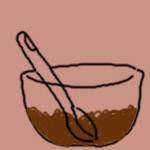| |
|

 |
 |
The origins of chocolate date back to the
ancient Aztec and Mayan cultures of Mexico and the Yucatan peninsula, when
the value of the cacao plant was discovered. Aztec legend holds that the
god Quetzalcoatl brought them a cacao tree from Paradise. He taught them
how to roast and grind the cacao seeds, making a rich paste that could
be dissolved in water. They added spices and called this drink "chocolatl,"
or bitter-water, and believed it brought universal wisdom and knowledge.
The word "chocolate" is derived from a combination
of the terms choco ("foam") and atl ("water"); early chocolate was always
a drink. As part of a ritual in twelfth-century Mesoamerican marriages,
a mug of frothy chocolate was shared.
Ancient Mexicans believed that Tonacatecutli,
the goddess of food, and Calchiuhtlucue, the goddess of water, were the
guardian goddesses of cocoa. Each year they performed human sacrifices
for the goddesses, giving the victim cocoa at his last meal.
Christopher Columbus is credited with bringing
cacao beans to Europe after his fourth visit to the New World, but they
were overlooked in favor of the many other treasures he found. This delectable
sweet, however, would not be over looked for long.
Chocolate was first noted as something extraordinary
in 1519 when Spanish explorer Hernando Cortez visited the court of Emperor
Montezuma of Mexico. Montezuma drank only chocolatl, a frothy beverage
of chocolate flavored with vanilla and spices the consistency of honey.
In 1528 Cortez brought chocolate back from Mexico to the royal court of
King Charles V. Monks, hidden away in Spanish monasteries, processed the
cocoa beans and kept chocolate a secret for nearly a century. Only after
Spain declined as an international power in the seventeenth century did
the secret of chocolate spread to other parts of Europe.
Next Page
|
|
|
|
|
|
|



